Overview
- Brief Narrative
- Watercolor painting by Richard Kiwit (or Kivit) and gifted to Rachel Greene Rottersman, director of the United Nations Relief and Rehabilitation Administration (UNRRA) Aglasterhausen Children’s Center, in Unterschwarzach, Germany. The painting depicts the third floor balconies of the living quarters for Rachel and Joseph Rottersman and Dr. Dagmar Kiwit. These buildings also housed the infant nursery, a gym, and a chapel. Richard Kiwit was a well-known Estonian illustrator who moved to Germany in 1944. His daughter, Dagmar Elisabeth Kiwit (later Moder), was a pediatrician, and following the war worked as a Medical Officer at Aglasterhausen Children’s Center. The children’s center opened in October 1945, and employed UNRRA personnel, skilled staff from the displaced persons (DP) population, and local German maintenance workers. The children lived in a structured environment, received classroom instruction, participated in music and arts, enjoyed planned recreation time, and were responsible for regular chores. The UNRRA ceased its DP operations in June 1947. However, the children’s center remained open with the assistance of the Preparatory Commission of the International Refugee Organisation (PCIRO). During Rachel Green Rottersman’s tenure, between September 1945 and February 1948, 1,000 children had been cared for at Aglasterhausen. Of those, approximately one-third were repatriated to their native countries in Europe, 100 were reunited with their parents in Germany, and 350 were sent to the United States and Canada for adoption or foster care.
- Date
-
creation:
1947
- Geography
-
depiction:
Aglasterhausen (Displaced persons camp);
Schwarzach (Baden-Württemberg, Germany)
- Credit Line
- United States Holocaust Memorial Museum Collection, Gift of John Blair Rottersman
- Signature
- lower right corner, handwritten, paint: R. Kiwit
- Contributor
-
Subject:
Richard M. Kiwit
Artist: Richard M. Kiwit
Original owner: Rachel Greene Rottersman
Subject: Rachel Greene Rottersman
Subject: United Nations Relief and Rehabilitation Administration (UNRRA)
- Biography
-
Richard Martin Karl Kiwit (or Kivit, 1888-1981) was born in Tartu, Estonia. In 1904, he began studying art at the Tartu German Artisans Association, and went on to publish illustrations and cartoons. Among his works was a popular series of Estonian children’s books. Richard married Salme Adele Margarete Martin (1891-?), and in 1912, their daughter, Dagmar Elisabeth Kiwit (later Moder 1912-?), was born. In 1944, he immigrated to Germany, where he worked for the publisher, Herba & Schneider, and the Stuttgart and Karlsruhe Museum of Natural History. Dagmar became a pediatrician, and following World War II, worked as a Medical Officer at the Aglasterhausen Children’s Center, run by the United Nations Relief and Rehabilitation Administration (UNRRA).
Rachel Blair Greene (later Rottersman, 1908-1993) was born in Seattle, Washington, to William (1874-1947) and Ada (nee Prall, 1877-1929) Greene. Rachel had three brothers, George (1907-1979), Robert (1912-1993), and William, Jr. (1917-2012). William was a lawyer, and the family lived in a large home. They employed a housekeeper, and owned a local movie theater. At age 12, Rachel and a friend began helping care for children from a local orphanage, and gave clothing to a classmate whose family had recently immigrated to the United States. When Rachel was 14, her mother was diagnosed with breast cancer while traveling on the east coast, and Rachel took over as the primary caregiver for her brothers.
In 1926, Rachel enrolled at the University of Washington in Seattle, and focused on premedical studies at her father’s insistence. During Rachel’s third year, her mother died, leading Rachel to drop out of school. In 1931, Rachel joined a government relief organization, a step that aligned with her teenage dream of becoming a social worker. After multiple federal and state assignments, she resigned in early 1936 and reenrolled at the University of Washington, graduating in December 1936. The following month, she began attending the School of Social Service Administration at the University of Chicago. After completing qualifying exams for her Ph.D., Rachel became an assistant professor in social welfare at the University of California, Berkeley.
In October 1944, Rachel joined the United Nations Relief and Rehabilitation Administration (UNRRA). After a few months of training, she sailed for Europe and arrived in England in January 1945. Her first assignment was to aid arrivals as part of Team 18 at a displaced persons (DP) camp in Kirchberg, Germany. Rachel then worked at Baumholder DP camp, where she assisted in the repatriation of over 20,000 refugees to their home countries. She also helped combat a typhoid epidemic in the camp. After the camp was closed, Rachel was assigned to work at a staging center from July to September 1945.
On September 11, 1945, Rachel became the team director of a children’s home located at an estate just outside the village of Unterschwarzach (now Schwarzach, Germany). The estate, formerly an Evangelical industrial training school called Schwacher Hof, was renamed Aglasterhausen Children’s Center. Rachel spent approximately a month directing the renovation of the estate and hiring personnel, including UNRRA employees, skilled staff from the DP population, and local German maintenance workers. The children’s center opened in October 1945, and by the end of the year housed over 140 children, representing 15 nationalities. Rachel prioritized a structured environment, so the children had classroom instruction, music and arts, planned recreation time, as well as regular chores. In the spring of 1946, the population topped 200 children, repatriation of Polish children began, and 35 children were allowed to immigrate to the United States. Rachel was able to arrange for one of her brothers and his wife to adopt one of the babies from Aglasterhausen.
In January 1947, Josef Rottersman (1914-2008), a Polish Jew who fled to Russia and served as a dentist for the Russian Army, arrived at Aglasterhausen to offer his services. Although the center already had a dentist, Rachel found a position for him and the pair soon fell in love. They married on May 22, and held a reception at Aglasterhausen. The UNRRA ceased its DP operations in June 1947. However the children’s center remained open with the assistance of the Preparatory Commission of the International Refugee Organisation (PCIRO). After Rachel became pregnant in the fall of 1947, the couple made plans to move to the United States. Rachel resigned from her post on January 15, 1948, and left Germany on February 3, 1948. Josef was able to join her the following month, and changed his name to Joseph. Between September 1945 and February 1948, 1,000 children had been cared for at Aglasterhausen. Of those, approximately one-third were repatriated to their native countries in Europe, 100 were reunited with their parents in Germany, and 350 were sent to the United States and Canada for adoption or foster care. In March 1948, MGM released a film called “The Search,” featuring a children’s home and matron based on Aglasterhausen and Rachel. The film won two Academy Awards and two Golden Globes, amongst other awards and nominations, in 1949.
Rachel and Joseph moved to Chicago in 1948. There, Rachel worked for aid agencies as a social worker and later became a teacher. Their first child, Helena (b. 1948), died in infancy. They had another child, John (b. 1949), later the following year. Joseph became a naturalized United States citizen in 1950.
The United Nations Relief and Rehabilitation Administration (UNRRA) was an international relief agency representing 44 nations, but largely dominated by the United States. Founded in 1943, it became part of the United Nations (UN) in 1945, and it largely shut down operations in 1947. Its purpose was to "plan, co-ordinate, administer or arrange for the administration of measures for the relief of victims of war in any area under the control of any of the United Nations through the provision of food, fuel, clothing, shelter and other basic necessities, medical and other essential services." Its staff of civil servants included 12,000 people, with headquarters in New York. Funding came from many nations, and totaled $3.7 billion, of which the United States contributed $2.7 billion; Britain $625 million and Canada $139 million. The Administration of UNRRA at the peak of operations in mid-1946 included five types of offices and missions with a staff totaling nearly 25,000: The Headquarters Office in Washington, The European Regional Office (London), the 29 servicing offices and missions (2 area offices in Cairo and Sydney; 10 liaison offices and missions in Belgium, Denmark, France, Italy, Luxembourg, the Netherlands, Norway, Sweden, Switzerland, Trieste; 12 procurement offices in Argentina, Brazil, Chile and later Peru, Cuba, India, Mexico, South Africa, Southern Rhodesia, Turkey, Uruguay, Venezuela; 6 offices for procurement of surplus military supplies in Caserta and later Rome, Honolulu, Manila, New Delhi, Paris, Shanghai), the sixteen missions to receiving countries (Albania, Austria, Byelorussia, China, Czechoslovakia, the Dodecanese Islands, Ethiopia, Finland, Greece, Hungary, Italy, Korea, the Philippines, Poland, Ukraine, Yugoslavia), and the Displaced Persons Operations in Germany.
UNRRA cooperated closely with dozens of volunteer charitable organizations, who sent hundreds of their own agencies to work alongside UNRRA. In operation only three years, the agency distributed about $4 billion worth of goods, food, medicine, tools, and farm implements at a time of severe global shortages and worldwide transportation difficulties. The recipient nations had been especially hard hit by starvation, dislocation, and political chaos. It played a major role in helping Displaced Persons return to their home countries in Europe in 1945-46. Its UN functions were transferred to several UN agencies, including the International Refugee Organization and the World Health Organization. As an American relief agency, it was largely replaced by the Marshall Plan, which began operations in 1948. [Source: UN Original finding aid of records of the United Nations Relief and Rehabilitation Administration (UNRRA)]
Physical Details
- Classification
-
Art
- Category
-
Paintings
- Object Type
-
Watercolor painting (lcsh)
- Genre/Form
- Landscape paintings.
- Physical Description
- Rectangular, watercolor and gouache painting on light cream-colored paper. The painting depicts a set of buildings along an L-shaped street flanked with plants. To the right of the street are two intersecting rows of low, green shrubs in front of a stand of tall trees. To the left of the street are three buildings with a partial tree in the foreground. The first two buildings have three stories topped by red and orange roofs. The top floor of each has a balcony with flowers. The front building has a brown, arched door on the side, and a small, green courtyard separating it from the second building. Barely visible in the background, the third building is single-story and has an orange roof. The artist’s signature is painted into the lower right corner. The back of the painting is heavily discolored and stained.
- Dimensions
- overall: Height: 14.750 inches (37.465 cm) | Width: 17.375 inches (44.133 cm)
- Materials
- overall : paper, paint, gouache, graphite
Rights & Restrictions
- Conditions on Access
- No restrictions on access
- Conditions on Use
- No restrictions on use
Keywords & Subjects
- Topical Term
- Adoption. Emigration and immigration. Refugee children--Germany--Aglasterhausen. Jewish children--Germany--Aglasterhausen. Holocaust survivors--Germany--Aglasterhausen. Orphanages--Germany--Aglasterhausen. Jewish children in the Holocaust. World War, 1939-1945--Children.
- Geographic Name
- Aglasterhausen (Germany) Schwarzach (Baden-Württemberg, Germany)
- Personal Name
- Kivit, Richard.
Administrative Notes
- Legal Status
- Permanent Collection
- Provenance
- The painting was donated to the United States Holocaust Memorial Museum in 2015 by John B. Rottersman, the son of Rachel Greene Rottersman
- Record last modified:
- 2023-08-25 09:52:46
- This page:
- https://collections.ushmm.org/search/catalog/irn183414
Download & Licensing
In-Person Research
- By Appointment
- Request 21 Days in Advance of Visit
- Plan a Research Visit
- Request to See This Object
Contact Us
Also in Rachel Greene Rottersman collection
The collection consists of paintings, audio recordings, correspondence, documents, reports, and writings related to the experiences of Rachel Greene Rottersman during her career with UNRRA and her work at the children’s home at Aglasterhausen, Germany, assisting displaced children after World War II.
Date: 1939-2015
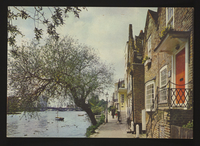
Rachel Greene Rottersman papers
Document
The Rachel Greene Rottersman papers consist of biographical materials about Rottersman’s UNRRA career; correspondence and reports about the children’s home at Aglasterhausen; notes and drafts for the memoirs Rottersman never completed; photographs of children and employees at Aglasterhausen; and printed materials about UNRRA’s work with displaced children. Biographical materials include student records, UNRRA and IRO (International Relief Organization) personnel records, and resumes for Rachel Rottersman and immigration application paperwork for Joseph Rottersman. This series also includes biographies of Rachel Rottersman prepared by Tommy Thompson and John Blair Rottersman. Correspondence consists of postwar letters documenting Rottersman’s work with UNRRA, displaced children, and the Aglasterhausen home as well as follow up correspondence from later decades with former Aglasterhausen staff and children. Postwar correspondence includes a copy of Rottersman’s “diary,” which was actually periodic correspondence without specific addressee that describes Rottersman’s life in Germany, work with UNRRA, and the Aglasterhausen children’s home in great detail. It appears as though these “diary” letters were intended to be circulated among Rottersman’s family and friends. Postwar correspondence also includes Rottersman’s letters to her father, which often duplicate the “diary” letters but intersperse personal correspondence, replies to his letters, and gratitude for the packages he sent her. Her father’s letters are included in the correspondence series, contain his advice, and document their differences of opinion. Postwar correspondence with other family members, friends, coworkers, and displaced children document the children’s pasts, hopes for the future, and immigration journeys and relay Rottersman’s family and Aglasterhausen news and requests for supplies. Postwar correspondence also includes a handful of letters documenting the UNRRA and Aglasterhausen business of taking care of children’s health, planning for their futures, and managing staffing and supplies. Follow up correspondence from later decades documents Rottersman’s efforts to maintain contact with former Aglasterhausen children and staff and describes family news, memories about the Aglasterhausen years, and Rottersman’s project to write a book about her experiences. This series also includes a few hand illustrated cards. The memoirs series primarily consists of drafts of chapters or scenes Rachel Rottersman apparently intended to include in her memoirs, a project she never completed. Some of the chapters have identifiable titles, while others correspond more closely to entries from her “diary” correspondence. This series also includes correspondence and commentary from reviewers of preliminary chapters as well as notes for additional scenes. Photographs primarily depict children, staff, buildings, and countryside around the Aglasterhausen center. Most of the photographs of Rachel and Joseph Rottersman have been separated into distinct folders. This series also includes a handful of photographs form the Baumholder Assembly Center for Displaced Persons and a photograph from the Kirchberg Assembly Center. Printed materials include clippings about Rachel Rottersman, displaced persons, unaccompanied children, Lebensborn children, the Lidice massacre, 1946 and 1947 journeys of the Marine Flasher and Marine Marlin that carried Aglasterhausen children to the United States, and the movie “The Search”; full or partial issues of newspapers such as UNRRA DP News, UNRRA Team News, and Nasza Gazeta; copies of military and displaced person newsletters including The Port Hole and Homeward Bound; and published reports about Aglasterhausen and displaced and unaccompanied children. This series also includes picture postcards from England, France, and Germany. The reports series includes individualized reports about Aglasterhausen children, name lists of Aglasterhausen children and staff, Aglasterhausen policies and procedures, narratives and UNRRA reports about the experiences of displaced and unaccompanied children, court records related to United States of America vs. Ulrich Greifelt, et al (Lebensborn case), and additional reports related to Lebensborn children.
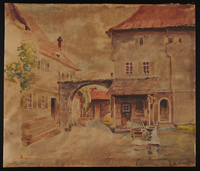
Watercolor painting of a courtyard given to an UNRRA official
Object
Watercolor painting of a courtyard in the city of Markgröningen, Germany, painted by artist Richard Kiwit (or Kivit) and gifted to Rachel Greene Rottersman, director of the United Nations Relief and Rehabilitation Administration (UNRRA) Aglasterhausen Children’s Center, in Unterschwarzach, Germany. Markgröningen is a city located 20 kilometers northwest of Stuttgart, and about 60 kilometers south from Aglasterhausen. Richard Kiwit was a well-known Estonian illustrator who moved to Germany in 1944. His daughter, Dagmar Elisabeth Kiwit (later Moder), was a pediatrician, and following the war worked as a Medical Officer at Aglasterhausen Children’s Center. The children’s center opened in October 1945, and employed UNRRA personnel, skilled staff from the displaced persons (DP) population, and local German maintenance workers. The children lived in a structured environment, received classroom instruction, participated in music and arts, enjoyed planned recreation time, and were responsible for regular chores. The UNRRA ceased its DP operations in June 1947. However, the children’s center remained open with the assistance of the Preparatory Commission of the International Refugee Organisation (PCIRO). During Rachel Green Rottersman’s tenure, between September 1945 and February 1948, 1,000 children had been cared for at Aglasterhausen. Of those, approximately one-third were repatriated to their native countries in Europe, 100 were reunited with their parents in Germany, and 350 were sent to the United States and Canada for adoption or foster care.
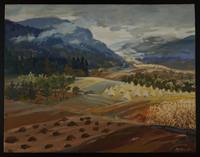
Watercolor painting of farm fields given to an UNRRA official
Object
Watercolor painting of farm fields in the German countryside, painted by artist Richard Kiwit (or Kivit) and gifted to Rachel Greene Rottersman, director of the United Nations Relief and Rehabilitation Administration (UNRRA) Aglasterhausen Children’s Center, in Unterschwarzach, Germany. Richard Kiwit was a well-known Estonian illustrator who moved to Germany in 1944. His daughter, Dagmar Elisabeth Kiwit (later Moder), was a pediatrician, and following the war worked as a Medical Officer at Aglasterhausen Children’s Center. The children’s center opened in October 1945, and employed UNRRA personnel, skilled staff from the displaced persons (DP) population, and local German maintenance workers. The children lived in a structured environment, received classroom instruction, participated in music and arts, enjoyed planned recreation time, and were responsible for regular chores. The UNRRA ceased its DP operations in June 1947. However, the children’s center remained open with the assistance of the Preparatory Commission of the International Refugee Organisation (PCIRO). During Rachel Green Rottersman’s tenure, between September 1945 and February 1948, 1,000 children had been cared for at Aglasterhausen. Of those, approximately one-third were repatriated to their native countries in Europe, 100 were reunited with their parents in Germany, and 350 were sent to the United States and Canada for adoption or foster care.
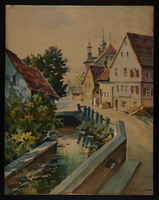
Watercolor painting of a street scene given to an UNRRA official
Object
Watercolor painting of a bridge and road to the village of Unterschwarzach, painted by artist Richard Kiwit (or Kivit) and gifted to Rachel Greene Rottersman, director of the United Nations Relief and Rehabilitation Administration (UNRRA) Aglasterhausen Children’s Center, in Unterschwarzach, Germany. Richard Kiwit was a well-known Estonian illustrator who moved to Germany in 1944. His daughter, Dagmar Elisabeth Kiwit (later Moder), was a pediatrician, and following the war worked as a Medical Officer at Aglasterhausen Children’s Center. The children’s center opened in October 1945, and employed UNRRA personnel, skilled staff from the displaced persons (DP) population, and local German maintenance workers. The children lived in a structured environment, received classroom instruction, participated in music and arts, enjoyed planned recreation time, and were responsible for regular chores. The UNRRA ceased its DP operations in June 1947. However, the children’s center remained open with the assistance of the Preparatory Commission of the International Refugee Organisation (PCIRO). During Rachel Green Rottersman’s tenure, between September 1945 and February 1948, 1,000 children had been cared for at Aglasterhausen. Of those, approximately one-third were repatriated to their native countries in Europe, 100 were reunited with their parents in Germany, and 350 were sent to the United States and Canada for adoption or foster care.
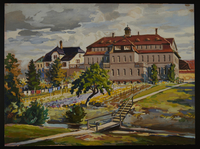
Painting of a large estate given to an UNRRA official
Object
Watercolor painting of the United Nations Relief and Rehabilitation Administration (UNRRA) Aglasterhausen Children’s Center, in Unterschwarzach (now Schwarzach), Germany, painted by artist Richard Kiwit (or Kivit) and gifted to Rachel Greene Rottersman, director of Aglasterhausen. Richard Kiwit was a well-known Estonian illustrator who moved to Germany in 1944. His daughter, Dagmar Elisabeth Kiwit (later Moder), was a pediatrician, and following the war worked as a Medical Officer at Aglasterhausen Children’s Center. The children’s center opened in October 1945, and employed UNRRA personnel, skilled staff from the displaced persons (DP) population, and local German maintenance workers. The children lived in a structured environment, received classroom instruction, participated in music and arts, enjoyed planned recreation time, and were responsible for regular chores. The UNRRA ceased its DP operations in June 1947. However, the children’s center remained open with the assistance of the Preparatory Commission of the International Refugee Organisation (PCIRO). During Rachel Green Rottersman’s tenure, between September 1945 and February 1948, 1,000 children had been cared for at Aglasterhausen. Of those, approximately one-third were repatriated to their native countries in Europe, 100 were reunited with their parents in Germany, and 350 were sent to the United States and Canada for adoption or foster care
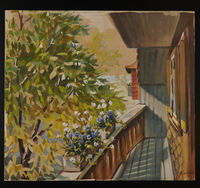
Watercolor painting of a children’s home given to an UNRRA official
Object
Watercolor painting of the view from balcony of Dagmar Kiwit’s room, painted by her father, artist Richard Kiwit (or Kivit) and gifted to Rachel Greene Rottersman, director of the United Nations Relief and Rehabilitation Administration (UNRRA) Aglasterhausen Children’s Center, in Unterschwarzach, Germany. Richard Kiwit was a well-known Estonian illustrator who moved to Germany in 1944. Dagmar Elisabeth Kiwit (later Moder), was a pediatrician, and following the war, worked as a Medical Officer at Aglasterhausen Children’s Center. The children’s center opened in October 1945, and employed UNRRA personnel, skilled staff from the displaced persons (DP) population, and local German maintenance workers. The children lived in a structured environment, received classroom instruction, participated in music and arts, enjoyed planned recreation time, and were responsible for regular chores. The UNRRA ceased its DP operations in June 1947. However, the children’s center remained open with the assistance of the Preparatory Commission of the International Refugee Organisation (PCIRO). During Rachel Green Rottersman’s tenure, between September 1945 and February 1948, 1,000 children had been cared for at Aglasterhausen. Of those, approximately one-third were repatriated to their native countries in Europe, 100 were reunited with their parents in Germany, and 350 were sent to the United States and Canada for adoption or foster care
Painting of an estate given to an UNRRA official
Object
Painting of the United Nations Relief and Rehabilitation Administration (UNRRA) Aglasterhausen Children’s Center, in Unterschwarzach (now Schwarzach), Germany, owned by the director, Rachel Greene Rottersman. The children’s center opened in October 1945, and employed UNRRA personnel, skilled staff from the displaced persons (DP) population, and local German maintenance workers. The children lived in a structured environment, received classroom instruction, participated in music and arts, enjoyed planned recreation time, and were responsible for regular chores. The UNRRA ceased its DP operations in June 1947. However, the children’s center remained open with the assistance of the Preparatory Commission of the International Refugee Organisation (PCIRO). During Rachel Green Rottersman’s tenure, between September 1945 and February 1948, 1,000 children had been cared for at Aglasterhausen. Of those, approximately one-third were repatriated to their native countries in Europe, 100 were reunited with their parents in Germany, and 350 were sent to the United States and Canada for adoption or foster care.
Painting of a building complex given to an UNRRA official
Object
Painting of the United Nations Relief and Rehabilitation Administration (UNRRA) Aglasterhausen Children’s Center, in Unterschwarzach (now Schwarzach), Germany, painted by Henryk Michniak and given to Rachel Greene Rottersman, director of the Children’s Center. Henryk (or Henry) Michniak arrived at Aglasterhausen in November 1945, at age 16. While at Aglasterhausen, Henryk became known for his artwork, including cartoon characters painted on the walls of the nursery. The children’s center opened in October 1945, and employed UNRRA personnel, skilled staff from the displaced persons (DP) population, and local German maintenance workers. The children lived in a structured environment, received classroom instruction, participated in music and arts, enjoyed planned recreation time, and were responsible for regular chores. The UNRRA ceased its DP operations in June 1947. However, the children’s center remained open with the assistance of the Preparatory Commission of the International Refugee Organisation (PCIRO). During Rachel Green Rottersman’s tenure, between September 1945 and February 1948, 1,000 children had been cared for at Aglasterhausen. Of those, approximately one-third were repatriated to their native countries in Europe, 100 were reunited with their parents in Germany, and 350 were sent to the United States and Canada for adoption or foster care. Henryk left Aglasterhausen for Fellbach Emigration Center on May 22, 1946, and immigrated to the United States on June 8. Henryk became a naturalized citizen in 1951, served in the Korea and Vietnam Wars, and was awarded the Purple Heart. Henryk retired from the Army at the rank of Sergeant Major in November 1974, and was buried in Arlington National Cemetery after his death.
Painting of a building given to an UNRRA official
Object
Painting of entrance gates to the United Nations Relief and Rehabilitation Administration (UNRRA) Aglasterhausen Children’s Center, in Unterschwarzach (now Schwarzach), Germany, owned by the director, Rachel Greene Rottersman. The children’s center opened in October 1945, and employed UNRRA personnel, skilled staff from the displaced persons (DP) population, and local German maintenance workers. The children lived in a structured environment, received classroom instruction, participated in music and arts, enjoyed planned recreation time, and were responsible for regular chores. The UNRRA ceased its DP operations in June 1947. However, the children’s center remained open with the assistance of the Preparatory Commission of the International Refugee Organisation (PCIRO). During Rachel Green Rottersman’s tenure, between September 1945 and February 1948, 1,000 children had been cared for at Aglasterhausen. Of those, approximately one-third were repatriated to their native countries in Europe, 100 were reunited with their parents in Germany, and 350 were sent to the United States and Canada for adoption or foster care.
Painting of an outdoor domestic scene given to an UNRRA official
Object
Painting of a scene at the United Nations Relief and Rehabilitation Administration (UNRRA) Aglasterhausen Children’s Center, in Unterschwarzach (now Schwarzach), Germany, owned by the director, Rachel Greene Rottersman. The children’s center opened in October 1945, and employed UNRRA personnel, skilled staff from the displaced persons (DP) population, and local German maintenance workers. The children lived in a structured environment, received classroom instruction, participated in music and arts, enjoyed planned recreation time, and were responsible for regular chores. The UNRRA ceased its DP operations in June 1947. However, the children’s center remained open with the assistance of the Preparatory Commission of the International Refugee Organisation (PCIRO). During Rachel Green Rottersman’s tenure, between September 1945 and February 1948, 1,000 children had been cared for at Aglasterhausen. Of those, approximately one-third were repatriated to their native countries in Europe, 100 were reunited with their parents in Germany, and 350 were sent to the United States and Canada for adoption or foster care.



